Ten of the Best: Space Opera

Welcome to Ten of the Best, a semi-regular series of articles where I discuss ten of my favourite examples of various science fiction and fantasy subgenres. The plan is to add a new post to this series every couple of months and hopefully provide regular visitors with some new recommendations for books, series or authors they may not have come across before. Of course, it goes without saying that these lists are entirely subjective and entirely based on my own reading history at the time they’re compiled, and as a result they may be subject to change at some unspecified point in the future.
To get the ball rolling I’d like to start with the subgenre that represents my original introduction to science fiction and fantasy: Space Opera.
What is Space Opera?
Despite being one of the older subgenres of science fiction, Space Opera would appear to be one of the most difficult to pin down, in terms of what exactly it is. Back in the nineteen-forties when the term was first coined it was meant as a derogatory label, putting certain types of science fiction on a similar level as the pulp westerns (or horse operas). The man behind the term, Wilson Tucker, considered such sci-fi adventures to be formulaic and predictable, following worn out tropes and plot lines that in many cases had quite literally been lifted straight out of those same pulp westerns, and the name soon became synonymous with low quality yarns set on cardboard cutout spaceships.
This began to change in the seventies when publisher Del Rey Books began to question the idea that the genre was obsolete, and began to republish and repackage older works as Space Opera. This, coupled with the popularity of movies such as Star Wars, brought fresh attention to the genre and by the eighties and nineties the term was once again being recognised as a legitimate and worthwhile part of science fiction culture.
These days Space Opera is generally defined as adventure science fiction that includes massive, sweeping vistas (often of galactic scale) and space warfare between advanced space-faring civilisations, usually with the focus being on a handful of heroic protagonists and action-driven plot lines. Having said that, ask ten sci-fi fans what Space Opera is to them and you’ll almost certainly get ten different answers, though I guess you could argue the same could be said for science fiction as a whole.
Due to the massive scale of most Space Opera works, the majority of items on my top ten list are multi-book series, and as a whole the list represents works from the earliest days of modern science fiction through to the latest in cutting-edge sci-fi fare. If you haven’t already sampled the works of the authors on this list then I definitely recommend giving each of them a look-see.
The Lensman Series • E. E. ‘Doc’ Smith
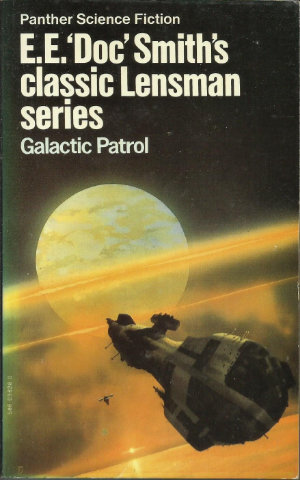
Edward Elmer Smith, known more commonly by his pen name of E.E. ‘Doc’ Smith, has often been described as the father of space opera, and one of his most famous works is the Lensman series. Made up of a core of four definitive novels, two supporting novels and a collection of short stories, the series laid the groundwork for a lot of the common themes and tropes found in early space opera, and is even cited by George Lucas (you may have heard of him) as being a major influence during his youth.
Originally the series was made up of four novels: Galactic Patrol (1940), Grey Lensman (1951), Second Stage Lensman (1953) and Children of the Lens (1954), though each had previously been serialised in the pages of Astounding Stories magazine between 1937 and 1948. These four novels are classic Space Opera, set against a backdrop of intergalactic war between “Civilisation” in the form of the Galactic Patrol and the piratical Boskonians. Leading the charge against the Boskonians and their masters is Kimball Kinnison, a larger-than-life figure equipped with the awesome power of the Lens, a device which the wearer to tap into various enhanced powers, including telepathy and mind-reading.
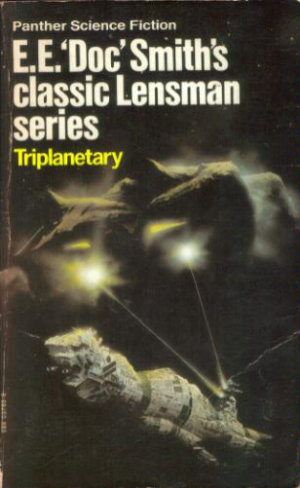
Once Children of the Lens reached the end of its run in Astounding, Smith went back and rewrote one of his earlier works, Triplanetary. This was original serialised in 1934 in Amazing Stories, and later published in novel form in 1948. The alterations made by Smith turned Triplanetary into a prologue to the core Lensman books. This was then followed in 1950 by the bridging novel First Lensman, set chronologically between Triplanetary and Galactic Patrol. The final book in the series specifically written by Smith is The Vortex Blaster (aka Masters of the Vortex), a collection of three short stories set between the events of Second Stage Lensman and Children of the Lens.
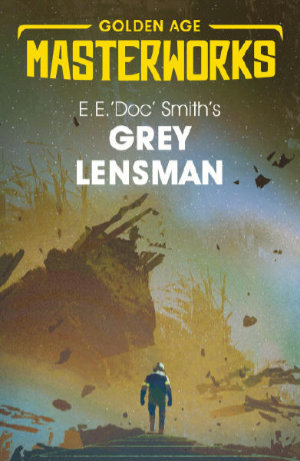
After the wonder that was Star Wars, the Lensman books were my first real foray into the many worlds of Space Opera and quickly sparked my imagination. I remember reading these and other works by Smith and being completely captivated by them. These books, along with the old TV serials of Flash Gordon and Buck Rogers, led to me developing a passion for all things science fiction and fantasy, a passion that’s stayed with me throughout my life. By modern standards they may be naive and simplistic, but for me they will always represent the true golden age of early science fiction, and the place where my interest in the genre began.
If you want to dip your toes into the Lensman pond then Gollancz have recently reissued the four core books in their Golden Age Masterworks series. You may also want to take a look at the earlier Skylark series, comprising The Skylark of Space (1946), Skylark Three (1948), Skylark of Valeron (1949) and Skylark DuQuesne (1966).
The Dune Saga • Frank Herbert
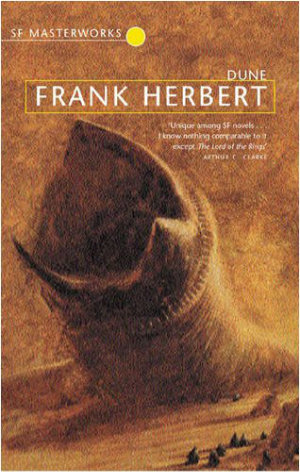
Quite possibly one of the most famous science fiction works of all time, the Dune Saga is massive in its scale and scope. It tells the story of the interstellar Padishah Empire, the rise of House Atreides and their control of the planet Arakis where the spice melange is harvested, the ascension of Paul Atreides to the imperial throne and the subsequent reign and fall of Paul’s son, Leto II. After the death of Leto II, the God Emperor, war sweeps through the galaxy and new alliances are formed in order to deal with a previously unknown enemy.
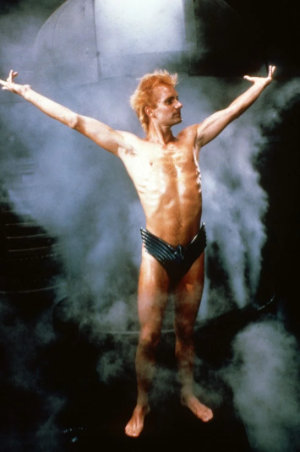
Frank Herbert himself wrote six books in the series, covering a period of roughly five thousand years of in-universe history. The first of these novels, Dune (1965), is the one most readers will be familiar with, mainly thanks to the lavish movie adaptation released in 1984. Written and directed by David Lynch, the project catapulted Herbert’s seminal work into the public consciousness and gifted us forever with the wonderful image of British pop star Sting flouncing around in naught but a fetching pair of leather shorts. Marvellous!
Unfortunately for Sting and his leather pants, the poor performance of the film at the box office and generally negative reviews from critics (it won the 1984 Stinkers Bad Movie Award for Worst Picture) meant that plans to adapt the remaining books fell by the wayside. However, for newcomers to the franchise there were still five more books out there for them to latch on to. The original novel was followed by Dune Messiah (1969), Children of Dune (1976), God Emperor of Dune (1981), Heretics of Dune (1984) and Chapterhouse: Dune (1985).
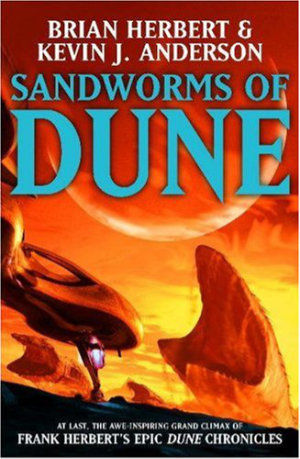
After Frank Herbert’s death in 1986 his son, Brian Herbert, enlisted author Kevin J. Anderson to help him add further chapters to the Dune Saga. To date the duo have produced a further thirteen novels, some developed from Frank Herbert’s own notes. Two in particular tie up storylines that begin in Heretics of Dune, effectively making Hunters of Dune (2006) and Sandworms of Dune (2007) the final novels in the saga as a whole, though I’ll admit I’ve not personally read these last two.
The Dune Saga for me will always be one of the greatest science fiction works of all time. The world-building is exemplary, with Herbert having imagined and presented in exquisite detail almost every aspect of his creation. This, plus the depth of character for all the major players, makes this series a benchmark for almost everything that comes after to be measured by. Not for nothing did it win both the Hugo and Nebula awards following its publication.
The Faded Sun Trilogy • C. J. Cherryh
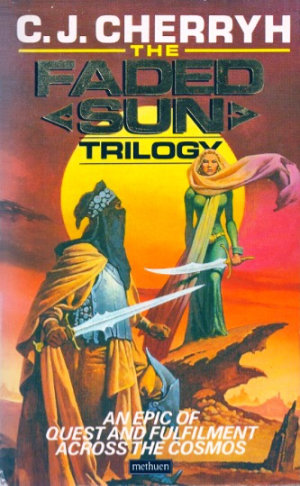
The Faded Sun Trilogy (1978-79) was my first encounter with the writing of C. J. Cherryh, and to say it left a lasting mark on me would be something of an understatement.
Set in Cherryh’s larger Alliance-Union universe the story begins with the alien regul entering into a period of peace with the human race. As part of their agreement with humanity the regul have ceded the desert world of Kesrith but do so without informing the planet’s current inhabitants, the mri, a race of mercenary warriors who have served the regul for over two thousand years.
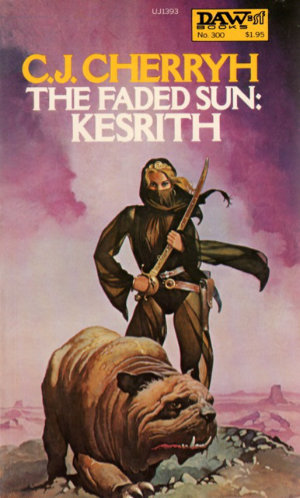
Pushed to the brink of extinction by the war with the humans, and betrayed by their regul masters, the two surviving mri, Niun and Melein, are captured by the human occupying force and set aboard a ship bound for the fabled mri home world, Kutath. Joining them in their journey is Sten Duncan, a highly trained human soldier.
The story then follows the three principal characters as they learn to get along and make their way to Kutath. Along the way, Duncan is forced to learn and adapt to mri ways when Melein, who has been unexpectedly thrust into the role of high priestess, declares that nothing that isn’t mri will be allowed to reach the end of the journey.
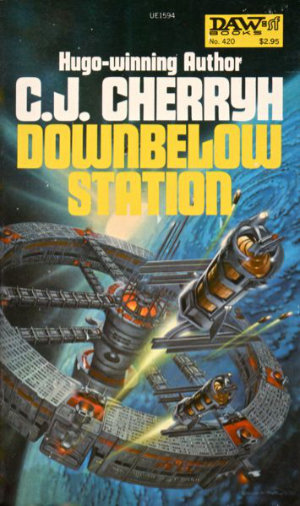
The three books of the trilogy represent some of Cherryh’s earliest works, but even so are amongst the best examples of her ability to write genuinely alien cultures. Both the mri and the regul are decidedly not human, especially in the way they think and reason, and yet Cherryh is still able to get the reader to empathise heavily with the two mri protagonists. In addition, by showing us the mri through the eyes of the human Sten Duncan we gain a marvellous insight into their remarkable culture without losing any of their inherently alien nature.
If you haven’t read any of the Cherryh’s work then this may be a good place to start, though bear in mind that a lot of the narrative is told from some very alien points of view. The characters definitely act true to their nature, but approaching this or many of Cherryh’s other works from an anthropocentric standpoint will diminish the overall impact of the story being told.
If, after reading this you’re eager for more, or indeed if you want to start with something a little less alien, you might enjoy dipping into the other works in her Alliance-Union universe. Personally I’d recommend giving Downbelow Station (1981) or Cyteen (1988) a try, though by all means feel free to explore all the many worlds C. J. Cherryh has given us over her remarkable career.
The Culture Cycle • Iain M. Banks
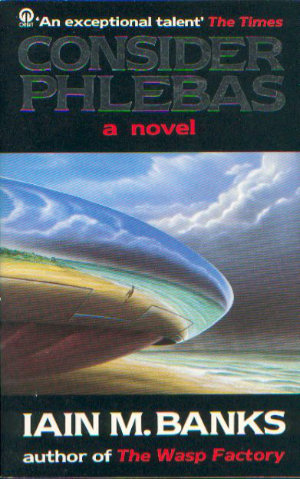
When Iain M. Banks’ first space opera novel came out he was already enjoying modest success with three mainstream novels published, The Wasp Factory (1984) being the most famous of these. Despite the popularity and the name he’d already made for himself, he first and foremost considered himself a science fiction writer, and Consider Phlebas (1987) was to be the first of thirteen novels and one collection he would eventually have published under the sci-fi banner.
As well as being the first of his science fiction novels, Consider Phlebas was also the first of what would eventually become known as The Culture Cycle, nine standalone novels linked by a common background. These nine novels, plus a couple of the stories from the aforementioned collection, The State of the Art (1991), would help to redefine space opera for a new generation of readers, and would eventually make Banks one of the most well-known names in modern sci-fi circles.
When Consider Phlebas first hit the shelves, science fiction was quite heavily dominated by cyberpunk and other works with a distinctly dystopian feel. Banks turned this idea on its head, presenting the Culture as a socialist utopia, a post-scarcity world where everyone has access to anything they desire and are free to do whatever they want in pursuit of happiness. Watching over this ideal society are the Minds, hyperdimensional machine intelligences that use their advanced intelligence to take care of the various biological and technological races that make up the Culture as a whole.
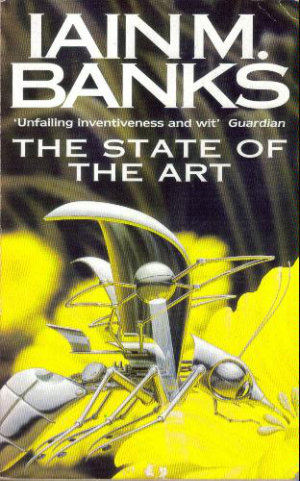
Despite the seemingly perfect setting of The Culture Cycle, there are still problems to be dealt with, both internally and externally. Consider Phlebas covers a single episode during the Culture’s war with the equally advanced Idirans, while other novels in the series show the machinations of the Minds and their agents in Contact (a combined diplomatic and military service) and Special Circumstances (Contact’s secret service and special forces organisation) as they try to keep the Culture ticking over smoothly and attempt to guide lesser civilisations down a path to cultural enlightenment.
Of the nine novels in The Culture Cycle, there are none that I’d consider weak links, though I do have my favourites. Excession (1996) was the first of Banks’ books I read, and as far as I’m concerned it’s an excellent gateway to the rest of the series. Because they’re all standalone and between them cover roughly a thousand years of Culture history you can read these books in any order you want, though I’d recommend reading Consider Phlebas before reading Look to Windward (2000), as the latter is indirectly affected by the events of the Idiran war setting of the former.
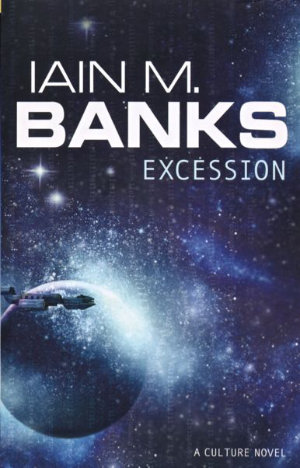
I’d also recommend Player of Games (1988) and Use of Weapons (1990) as potential starting points. Player of Games is the story of a famous game player who is cajoled into helping the Culture subvert and collapse an oppressive regime, while Use of Weapons tells the story of Cheradenine Zakalwe, a Special Circumstances operative who undertakes dangerous, often near-fatal missions interfering with the development of certain lesser civilisations, while trying to reconcile the horrors of his own past. Both books offer excellent insights into the Culture’s darker side as embodied by Special Circumstances.
As well as the books of The Culture Cycle, Banks also wrote four other science fiction works, with The Algebraist (2004) perhaps being the closest in feel and style to the Culture. I’d also recommend taking a look at his mainstream works, though bear in mind some of them, such as The Wasp Factory can be very dark indeed.
Revelation Space • Alastair Reynolds
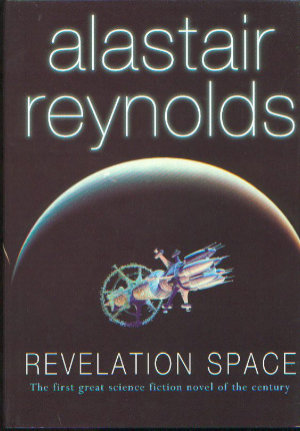
Compared to the Culture works of Banks, Alastair Reynolds’ Revelation Space universe presents us with a very different approach to space opera. Whereas Banks preferred to gloss over how the technology in his books worked, Reynolds brings a much more disciplined, almost hard science focus to his universe.
This is space opera in which faster-than-light travel is more-or-less none-existent, and while there are advanced alien races and cultures out there, most of the tech is grounded in what’s considered believable by our current understanding of science. This is hardly surprising when you take into account Reynolds’ background as a scientist and researcher working for the ESA.
The Revelation Space universe itself so far consists of six novels and several short stories and novellas, including the standalone novel Chasm City (2001) and the two books in the Prefect Dreyfus Emergencies series, but for me it’s the core trilogy that ensures Reynolds’ place on this list. Starting with the eponymous novel, Revelation Space (2000) and continuing with Redemption Ark (2002) and Absolution Gap (2003) the trilogy explores humanity’s first encounter with an ancient race known as the Inhibitors, and the war that ensues as a result of that encounter.
The bulk of the narrative covers a period of roughly two hundred years, though the full timeline of the novels stretches back to the Dawn War, a galactic war billions of years before the emergence of the human race. The Inhibitors are a left over remnant from that war, tasked with restricting the spread of intelligent life beyond individual planets or star systems. When humanity begins to reach out beyond the confines of its own solar system and inadvertently triggers an Inhibitor beacon, war breaks out and the various factions of the human race have to find a way of stopping the superior forces arrayed against them.
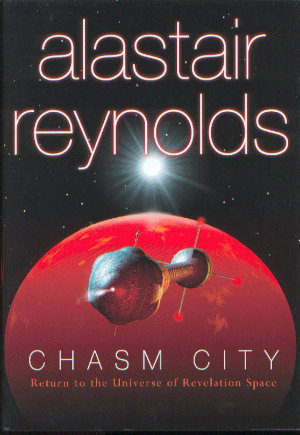
One of the things that stands out about this series is the way that Reynolds has avoided presenting human society as specifically utopian or dystopian. Instead, humanity is shown to be just as fractured and variable as we are today, complete with all the moral ambiguity of modern humanity, with as much potential for cruelty and corruption or kindness and benevolence. This gives the narrative a genuinely lived-in feel, grounding it in ways most space opera fails to achieve. Despite the advanced technology and interstellar setting, this still feels like a human interest story, with real people at its heart.
As well as the Revelation Space series, I’d also recommend taking a look at the Poseidon’s Children trilogy, starting with Blue Remembered Earth (2012). This is much more of a hard sci-fi trilogy, exploring the expansion of the human race into the solar system and beyond, focusing on the development of Africa as a growing superstate. More importantly, it has uplifted elephants, and that’s just too cool for words.
Imperial Radch • Ann Leckie
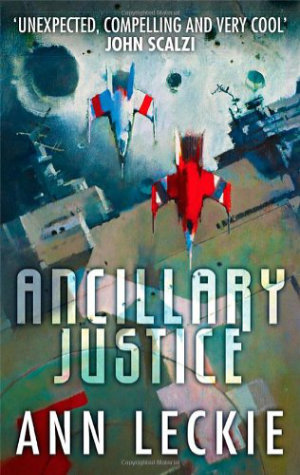
Ann Leckie’s Imperial Radch trilogy first hit the shelves in 2013 and right from the start it was making waves in the SFF community. The core narrative of the trilogy follows Breq, the sole survivor of a starship destroyed through treachery, as she sets out on a path to vengeance. What makes this more interesting is that Breq is also the vessel for that ship’s consciousness who was formerly connected to thousands of similar bodies, known as ancillaries.
When the first novel, Ancillary Justice (2013) first came out it received a lot of praise from commentators in the community, as well as a lot of award nominations and wins including the Hugo, Nebula, BSFA and Arthur C. Clarke Awards. It also generated a small amount of controversy within certain circles for its universal use of female pronouns, explained by the fact that the Radchaai, the dominant culture within the novels, do not differentiate due to gender. Even so, most people seemed to agree that it was an excellent read and a good start to a new trilogy.
The other two books in the trilogy, Ancillary Sword (2014) and Ancillary Mercy (2015) didn’t receive quite the same level of acclaim as the first one but they still found their way onto a few award ballots. As a whole the trilogy combines some of the classic tropes of old-school space opera with a modern approach to storytelling, and for me these books represent some of the best that contemporary science fiction has to offer.
Following the completion of the Imperial Radch trilogy Leckie went on to write Provenance (2017), a fourth novel set in the same universe but at a sizeable remove from the events of the trilogy. She has also more recently released a fantasy novel, The Raven Tower (2019).
Children of Time • Adrian Tchaikovsky
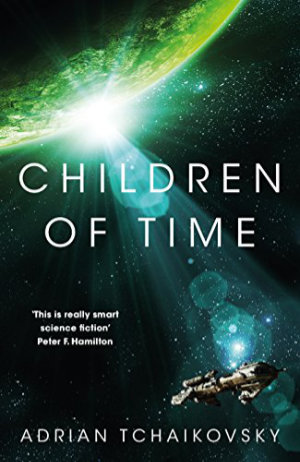
What do you get when you uplift a bunch of spiders on a distant planet and then leave them to figure out their own approach to society? Adrian Tchaikovsky certainly does a damned good job of exploring that question in his Arthur C. Clarke Award winning novel, Children of Time (2015). Of course, there’s more to this book than just following a bunch of evolved arachnids around for six hundred pages, but the fact that Tchaikovsky can make the reader feel genuine empathy for something as alien as a spider is a real testament to his skill as a writer.
When this book was initially released, Tchaikovsky was mostly known for his Shadows of the Apt series, a fantasy decalogy with elements of steampunk. Even so, the critics loved it and it’s now considered one of his best works. It’s certainly an outstanding piece of writing, splitting the narrative between the ever-evolving arachnids previously mentioned and a spaceship taking a slow crawl between star systems and its crew of the last remaining humans in the universe.
A sequel, Children of Ruin came out in 2019. This follows on from the end of Children of Time with the spiders and humans launching a joint venture to investigate a mysterious signal emanating from the stars, and while I haven’t personally read it yet I’ve heard a lot of good things about it.
I’d definitely count Children of Time as a modern classic, and while I appreciate not everyone will be swayed by the idea of intelligent, talking space spiders, I’d still recommend it to anyone with a love of epic, civilisation-spanning stories.
The Wayfarer Series • Becky Chambers
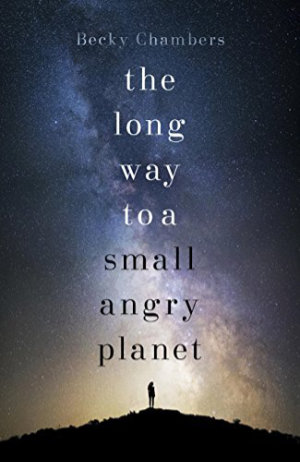
Most space opera tends to be about big things happening on a big stage; massive flotillas of heavily armed warships battling it out for control of an entire quadrant of the galaxy, or to decide the fate of the human race, for example. But as Becky Chambers’ Wayfarer series shows us, it doesn’t always have to be. Space opera can be just as fulfilling when it focuses in on the little things that happen to individuals in a small, enclosed environment.
Starting with The Long Way to a Small, Angry Planet (2014), Chambers has created a masterpiece in storytelling that many have dubbed ‘cosy sci-fi’. In this first book we get to meet the crew of the Wayfarer, a patched-up industrial ship that definitely gives off a much-loved vibe. Focusing on the personal interactions between the various crew members as they set out to build a hyperspace tunnel to a distant star system, Chambers introduces us to several distinct and unique alien cultures and makes the reader fall in love with every single member of that crew including the ship’s autonomous AI, Lovelace.
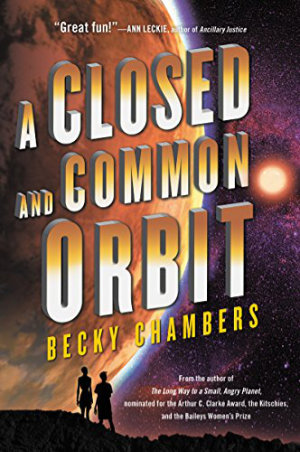
She followed this up with A Closed and Common Orbit (2016), which follows Lovelace as she tries to make a life for herself away from the Wayfarer, and reintroduces Pepper, a minor character from the first book. This was then followed by Record of a Spaceborn Few (2018) which gives a more focused look at one small part of the human race, and how the descendants of the original Exodans have adapted to their new home in a galaxy teeming with intelligence.
Each of these three books can be taken as a standalone story, though there are small links between all three and if you’re going to read one then I’d say you might as well read them all. All three books have picked up numerous award nominations, and I for one really hope we get to see more tales set in the Wayfarer universe.
Embers of War • Gareth L. Powell
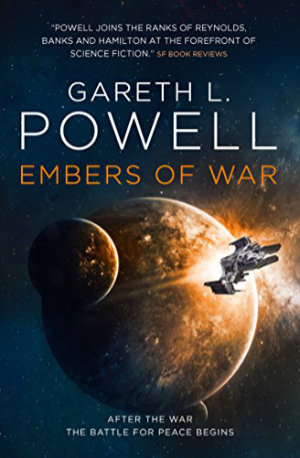
So far there have only been two books in this series, but with those two books Powell has already established himself as one of the great contemporary space opera writers.
The first novel, Embers of War (2018), introduces us to the Trouble Dog, a former warship turned rescue vessel, and her ragtag crew of misfits. What starts off fairly small, with a fumbled salvage mission on an ocean planet, soon snowballs into something with far-reaching consequences not just for the Trouble Dog’s crew but for the galaxy as a whole. Fleet of Knives (2019) follows this in much the same vein, but this time with all the dials turned up to eleven.
These books are, in no small way, reminiscent of Iain M. Banks at his best, and Powell is definitely a writer to watch out for. And while it may be a bit cheeky including an unfinished trilogy in a top-ten list, if the first two books are any indication the third and final instalment, Light of Impossible Stars (due February 2020), will be a cracking conclusion to an excellent series.
Ancestral Night • Elizabeth Bear
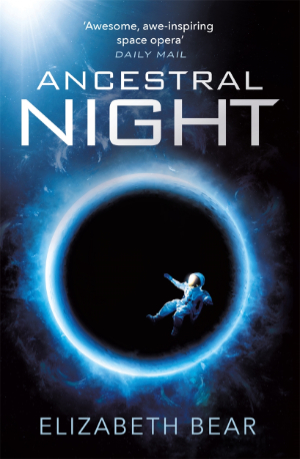
Ancestral Night (2019) is the first in an entirely new space opera duology from Elizabeth Bear, and damn if it isn’t one hell of an opener.
This is almost classic modern space opera, with a massive setting and a lot of big ideas. However, in this instance the action is all presented through the eyes of a single protagonist, Haimey Dz, and this makes the book feel very intimate and very personal, while still retaining the awe and wonder that’s become so integral to the genre.
There are so many layers to this story that you can’t just skim-read it, you really do have to focus on every step of the narrative. Once again there are shades of Banks in the make-up of the setting, but once again it’s presented in a way that makes it different enough to be fresh and invigorating. The second book in the series is due out in October 2020, and looks to be distinctly separate to the first book, though as the series has been pitched as a duology by Bear, it wouldn’t be too surprising if there’s some sort of overlap between the two.
So that’s it, my personal top ten space opera series so far. As I said at the top of this article, the list is compiled just from the books I’ve read over the last thirty-odd years and may well change as I read more and discover new authors. For example, I’ve only read the first book in James S. A. Corey’s Expanse series, but if that first book is anything to go on then there’s a good chance it’ll be replacing one of the ten entries above at some point. And there’s the entirety of Peter F. Hamilton’s oeuvre to explore at some point, which I’ve heard some very good things about over the years.
Anyway, what do you think? Are there any works you’d recommend based on what you’ve read here? Feel free to add your own top ten in the comments below, and by all means join me in a couple of months when I turn my attention to my top ten epic fantasy series.

Peter F Hamilton is very worth the read! Some of my favs on your list, and others to discover… thank you! 🙂
You’re welcome. 🙂
I’ve got a few of Peter F. Hamilton’s sat on my to-read shelf. I just need to make room for them in between all the other stuff I’ve got queued up right now.
Glad to see you started with E.E., most people seem to have forgotten him, but he basically invented the genre. Going to read a couple of the others on you rec.
To be fair I only started with E. E. ‘Doc’ Smith because the list’s in order of publication and Lensman’s the oldest series on the list. However, as I say in the write-up, Lensman’s also the series I most credit with getting me into the genre after Star Wars (thanks, Dad) so I couldn’t really leave them out, could I?